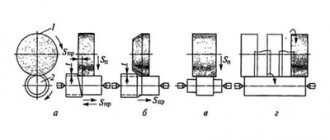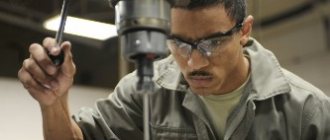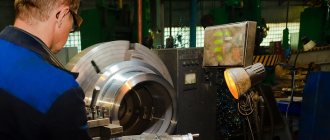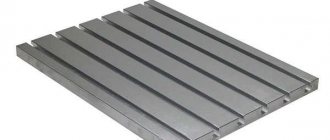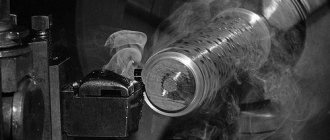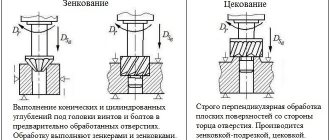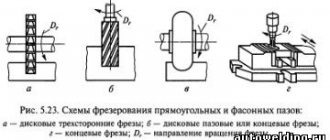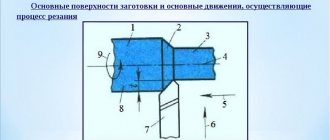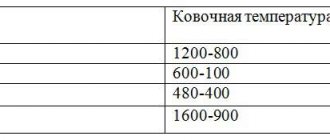Surface grinding is a type of grinding work that is performed using various methods. There are several types of surface grinding, which is performed on surface grinding machines. These include profile grinding, work with the periphery of a wheel, cross-feed of a wheel, creep-feed grinding, etc. Grinding with the end of a wheel is the most effective method, since it involves using the entire surface to be ground. To increase productivity, it is necessary to carefully attach parts to the machine table using a vice, clamping bars or electromagnetic plates.
Metal grinding
What is metal grinding? This technology means its processing using abrasive material. This process is carried out using a special technique and is designed to change the texture of the surface, as well as its other characteristics. Grinding is applied to the outer and inner parts of the metal (flat or cylindrical).
Metal processing characteristics:
- grinding is the final stage of metal processing, which is carried out to create roughness;
- the technology is not suitable for radically changing the dimensions of the product;
- It is possible to obtain the required degree of roughness using modern equipment after processing the workpiece under high temperature.
In the process of metal grinding, a number of features are taken into account:
- cutting depth;
- possibility of cross feeding;
- product movement speed;
- wheel speed (depending on equipment characteristics and outer diameter).
How to edit a grinding wheel
Mass and large-scale production contain devices for dressing on the grinding headstocks of machine tools. Single-piece and small-scale production obtain a given profile on the grinding wheel using a removable device. It is placed on the machine table (Fig. 6).
The dressing diamond 2 is mounted in a holder 4, which moves. At the bottom of the holder there is a tip for doing the work. It is pressed against the copier 6 by the force of the spring 5. From the rotation of the flywheel 1, the holder moves along the copier, transferring its profile to the grinding wheel 3. An identical device is used to edit the grinding wheel with a straight profile along a smooth copier.
Rice. 6. Universal device for dressing wheels on surface grinding machines: 1 – flywheel; 2 – ruling diamond; 3 – grinding wheel; 4 – power; 5 – spring; 6 – copier
Main types of grinding
Metal grinding is done using various methods. Technologies differ in the method of rotation (of a wheel or a workpiece), the speed of movement, as well as the side on which the grinder works (end, plane) and other factors. Main types of grinding:
- round;
- grinding of internal surfaces;
- gear grinding;
- centerless;
- flat.
Grinding methods are also classified according to the type of material used in the processing. To transfer the process to automatic mode, special machines or a built-in CNC unit are used, which reduces labor costs and ensures high quality products.
Cylindrical external grinding
Cylindrical grinding is the most popular method. It is not only external, but also internal. The circular method is carried out due to the synchronous rotation of the circle and the metal part. External grinding provides a cutting effect, and internal grinding provides uniform work.
Among the features of cylindrical grinding are:
- the abrasive wheel is a consumable material, it rotates around its own axis;
- the metal part rotates synchronously with the circle (this increases the efficiency of the process);
- Both longitudinal and transverse feeds are carried out (due to them, the depth of infeed changes and processing is ensured along the entire length).
This technology is suitable for processing cylindrical products, since when the circle comes into contact with a cylindrical product, the entire surface is processed.
Internal grinding
Internal grinding is similar to circular grinding, but differs in that the abrasive wheel is located inside the metal workpiece. Distinctive features of the technology:
- longitudinal and transverse feed can be carried out;
- the main rotation is provided by the abrasive wheel.
To increase the efficiency of the method, coolant is used. It is fed into the cutting zone.
Gear grinding
Gear grinding is a process that is carried out using gears. Hence the name. The complexity of the method lies in the fact that it is necessary to use technological equipment for grinding. Distinctive features of gear grinding:
- special machines are used for work;
- the circle is adjusted to the size of the tooth involute;
- the ring gear is processed.
The tooth surface is hardened, which can make machining the workpiece more difficult.
Centerless grinding
Centerless grinding is different in that the metal part is not fixed. The workpiece is placed between two grinding wheels that rotate. There is a stainless steel knife in the center, which eliminates the possibility of the product moving or jamming slightly.
Since the method involves the use of two grinding wheels at once, the process is much faster. Centerless grinding is carried out using special machines.
This technology is only possible in production workshops, and not at home.
Devices for fastening and installing grinding wheels on the machine
In Fig. Figure 2 shows how grinding wheels 3 with a cross-section of 30...100 mm are freely put on the spindle 1 of the machine. They are fastened with flanges 2, tightened with nuts 5. The flanges have the obligatory grooves, as well as gaskets 4 made of elastic rubber or leather. They promote uniform clamping of the circle around the perimeter.
Rice. 2. Devices for installing and fastening grinding wheels: 1 – spindle; 2 – flanges; 3 – grinding wheels; 4 – gaskets; 5 – nuts; 6, 7 – adapter flanges; 8 – annular groove; 9 - screws
Rice. 2 clearly demonstrates that grinding wheels 3 with a cross-section of more than 100 mm are mounted on adapter flanges 6 and 7 with a loose fit on the flange necks. Cardboard gaskets 4 are placed between the ends of the flanges. Bolts 9 connect both flanges. Weights for balancing are installed in the annular groove 8 of flange 7.
Sanding flat surfaces
Flat grinding is one of the simplest technologies, since it is carried out only by the movement of abrasive nozzles, without rotation of other elements. This method is used for the manufacture of presses and other flat products. The technology used has its own characteristics:
- the metal workpiece is placed on a special table and securely fastened to it mechanically or using a magnet;
- the workpiece is mounted on an electromagnetic table or using machine tools;
- The main movement is taken over by abrasive attachments.
Thanks to this technology, it is possible to grind the most complex shapes. During operation, to increase efficiency, you can pour coolant into the contact point between the tool and the metal product.
Lubrication
See also: Cutting fluid
Lubricants are sometimes used to cool the workpiece and wheel, lubricate the interface, and remove chips.
It should be applied directly to the cutting area to prevent the liquid from being carried away by the grinding wheel. Common lubricants include water-soluble chemical fluids, water-soluble oils, synthetic oils and petroleum-based oils. The type of lubricant used depends on the material of the workpiece and is indicated in the table below.[4] Types of lubricants used for grinding, depending on the workpiece material[4]
| Workpiece material | Lubrication |
| Aluminum | Heavy duty oil |
| Brass | Light oil |
| Cast iron | Emulsifying oil for heavy duty, chemical and synthetic oil for light duty |
| Mild steel | Water soluble heavy duty oil |
| Stainless steel | Emulsifying heavy duty oil, chemical and synthetic heavy duty oil |
| Plastics | Water soluble oil, heavy duty dry emulsifying oil, light chemical and synthetic oil |
Other metal grinding methods
There are also other, less common metal processing methods:
- Peeling – erasing the top layer if it has been damaged during use. After this, another sanding method must be used.
- Profiling is the most difficult technology, which involves working with a curve or broken line. This is the general name for gear grinding, thread grinding and spline grinding.
- Finishing – grinding, which is used to achieve shine and a polishing effect. This technology removes scratches and stains from the surface of the product.
Processing parts before grinding
Metal grinding is the final stage of processing, and it requires preliminary preparation. Before the process, it is necessary to process metal parts in several stages:
- Rough turning of the workpiece. At the first stage, the workpiece is given the required shape and dimensions, taking into account the allowance.
- Finish turning of metal. The workpiece is processed to the required size.
- Milling. This technology involves removing the workpiece mechanically. Milling is most often carried out on housing parts and gears.
- Metal processing under high temperature. The workpiece is hardened in order to significantly increase the hardness and strength of the surface. Annealing and tempering reduces the fragility of the product. In some cases, during the heat treatment process, certain chemicals are applied to the surface layer.
The Cherepovets metal structures plant has been working for you for more than 55 years. We design products, then manufacture them in our own workshops and deliver them throughout Russia. To order, call 8 or order a call on the website.
How are electromagnetic plates demagnetized?
Having completed the grinding operation, the part is removed from the table. Its residual magnetization is eliminated. This is facilitated by the demagnetization operation. The precision of grinding on machines and their productivity come from the efficiency and quality of demagnetization methods. The main priority of demagnetization is easy removal of the processed part from the table.
Reducing the duration of demagnetization significantly increases labor productivity on the machine. For the total time of auxiliary-preparatory and final operations, part of the table demagnetization time is 8...20%. Therefore, it is necessary to strive to reduce this period.
Unlike electromagnetic tables, magnetic tables do not require an energy source to power them. Permanent magnets made of nickel-aluminum alloy serve as poles for them. They are magnetized on special devices. The attraction of parts by magnetic plates is weaker than electromagnetic plates.
Rice. 4 shows a general view of the magnetic table. On top it is equipped with iron plates 1 and 2. Non-magnetic gaskets 3 are installed between them. High-power permanent magnets move and alternately close on the iron plates and on the fixed part. Handle 4 switches the magnets. The bottom of the plate is attached to the table with bolts and clamps.
Rice. 4. Magnetic plate with permanent magnets: 1, 2 – iron plates; 3 – non-magnetic layers; 4 – handle; 5 – permanent magnets
A special demagnetizer is placed in automatic grinding machines. Its function is to demagnetize processed steel parts. In addition to electromagnetic and magnetic plates, workpieces are mounted on machines:
- mounting strips;
- universal clamps;
- pattern vice;
- special plates.
In Fig. Figure 5 shows a pattern vice. They are more precise than a simple vice and can also be turned.
The sidewalls in the pattern vice are parallel to each other and perpendicular to the base. The vice is fastened through threaded holes. They are often attached to a magnetic plate. The device is made of steel, hardened and ground on all sides. When installing parts on a magnetic plate, use installation tiles with strips. They greatly increase the reliability of fastening parts to the plate.
Rice. 5. Pattern vice for securing sanded workpieces: 1 – fixed jaw; 2 – measuring pin; 3 – movable sponge; 4 – body; 5 – screw
